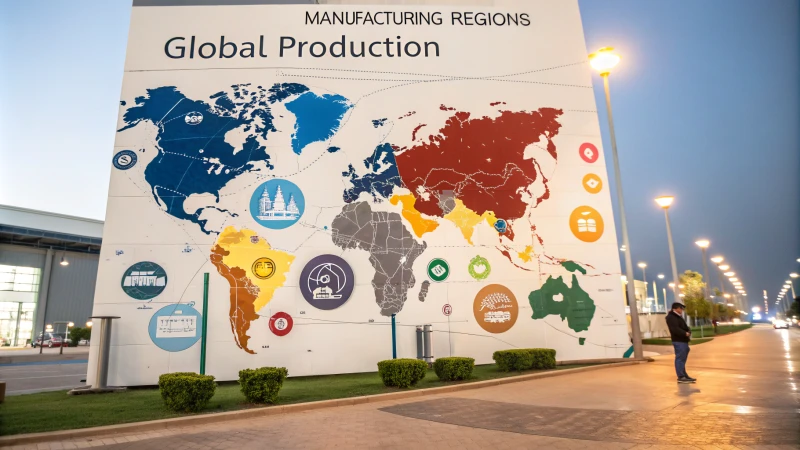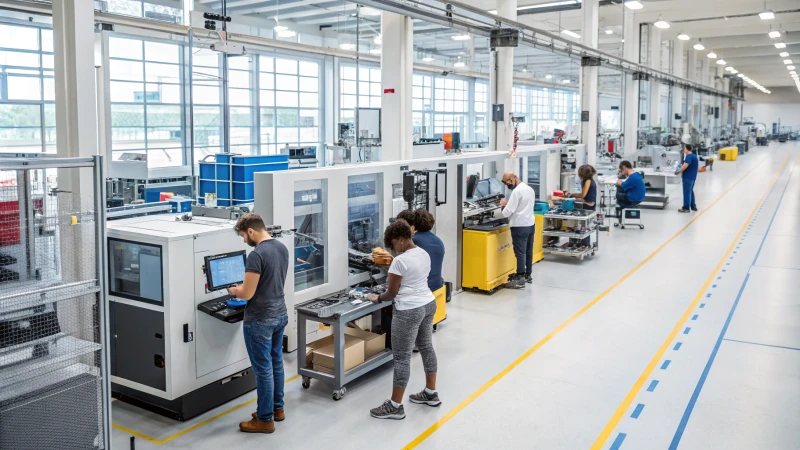
Explorer le monde en constante évolution du commerce mondial est mon aventure quotidienne. Les droits de douane sur les importations chinoises augmentent. C'est important.
Face aux défis posés par l'augmentation des droits de douane sur les produits chinois, j'ai découvert qu'il était essentiel de diversifier ma chaîne d'approvisionnement. J'ai exploré différents choix de fabrication au Viêt Nam, en Thaïlande et au Mexique. La protection des droits de propriété intellectuelle me donne une flexibilité très importante. Je peux déplacer la production si nécessaire.
Ces premières étapes me préparent à faire face aux pressions tarifaires. J'ai découvert qu'il était essentiel d'approfondir l'optimisation de la chaîne d'approvisionnement. La recherche de différentes stratégies a permis de protéger les finances de mon entreprise et de maintenir les opérations en cours. C'est important en ces temps imprévisibles. Chaque pas en avant renforce probablement ma résistance aux changements économiques.
La diversification des chaînes d'approvisionnement réduit l'impact tarifaire.Vrai
L'exploration d'autres pays, comme le Viêt Nam, peut réduire la dépendance à l'égard de la Chine.
Les droits de propriété intellectuelle ne sont pas pertinents pour la stratégie tarifaire.Faux
La garantie des droits de propriété intellectuelle permet une certaine souplesse dans la délocalisation de la production, ce qui facilite la stratégie.
Comment la diversification des origines de fabrication peut-elle profiter à votre chaîne d'approvisionnement ?
Vous êtes-vous déjà demandé pourquoi votre chaîne d'approvisionnement semblait instable, comme une tour de Jenga sur le point de tomber ? Changer l'endroit où vous fabriquez vos produits pourrait être la solution dont vous avez vraiment besoin. La diversification des origines est probablement très importante.
L'utilisation de différents pays pour la fabrication renforce votre chaîne d'approvisionnement. Cela réduit la dépendance à l'égard d'une seule source. Il est très probable que cela aide à gérer les risques politiques. Cette stratégie améliore la capacité d'adaptation aux changements du marché.

Atténuer les risques géopolitiques
Je me souviens d'avoir regardé les informations et d'avoir été angoissé par les négociations commerciales. Ces discussions pouvaient avoir des répercussions sur l'ensemble de mon entreprise. C'est à ce moment-là que j'ai compris l'importance d'avoir des usines dans différents pays. Cela sert de filet de sécurité et protège contre les problèmes politiques. Les Stratégie Chine+11 est un très bon exemple. Cette approche m'a permis de me sentir plus calme parce que je ne dépendais pas d'une seule région.
Accroître la flexibilité et la réactivité
Les droits de douane peuvent augmenter du jour au lendemain. De nombreuses personnes pourraient paniquer, mais pas si elles disposent de plusieurs sites de production. Le fait de disposer d'options au Mexique s'est avéré utile pour moi. Je pouvais rapidement y produire davantage pour faire face aux difficultés rencontrées dans d'autres pays.
Minimiser la dépendance à l'égard d'un seul fournisseur
Une fois, un fournisseur important n'a pas pu livrer en raison de problèmes inattendus. Cette situation difficile m'a appris qu'il était important de répartir les risques. Aujourd'hui, je travaille avec des fabricants dans différents domaines en partenariat avec les fabricants2. Si un fournisseur est confronté à des problèmes, les autres peuvent continuer à produire sans problème.
Sauvegarde de la propriété intellectuelle (PI)
La crainte de perdre le contrôle de mes créations m'a souvent troublé. Il était essentiel de protéger ma propriété intellectuelle dans tous les sites de production. Cette protection m'a permis de déplacer la production sans nuire à la qualité ou à l'image de marque de mon produit.
Trouver des partenaires fiables dans le monde entier
La recherche de partenaires dignes de confiance s'est avérée parfois très difficile. Les experts ou consultants locaux ont considérablement amélioré ma situation en m'aidant à trouver des partenaires fiables et en assurant le contrôle de la qualité. Des pays comme le Viêt Nam et la Thaïlande m'ont offert de nouvelles opportunités, tout en ayant une équipe locale de la chaîne d'approvisionnement3 en Chine ont simplifié les opérations et maintenu des normes élevées.
| Pays | Principaux avantages |
|---|---|
| Vietnam | Une main-d'œuvre bon marché, des politiques stables |
| Thaïlande | Infrastructure établie |
| Mexique | Proximité des marchés nord-américains |
| Cambodge | Opportunités des marchés émergents |
Diversifier les lieux de production ne protège pas seulement mon entreprise, mais ouvre aussi des perspectives de croissance. C'est comme avoir une boîte à outils très complète, prête à relever tous les défis que le monde présente.
La diversification des origines atténue les risques géopolitiques.Vrai
La multiplicité des origines de fabrication réduit l'impact de l'instabilité politique.
La dépendance à l'égard d'un seul fournisseur renforce la résilience de la chaîne d'approvisionnement.Faux
Le fait de dépendre d'un seul fournisseur augmente les risques, pas la résilience.
Pourquoi la propriété intellectuelle est-elle importante lors de la délocalisation de la production ?
Avez-vous déjà réfléchi à l'importance de la propriété intellectuelle lors du transfert de la production ? La propriété intellectuelle implique des idées et des inventions uniques. Celles-ci sont très importantes pour le succès d'une entreprise. Sans protection, les concurrents risquent de copier les idées. Cela réduit les bénéfices du créateur original. La protection de la propriété intellectuelle permet de préserver la créativité et l'innovation. Cette étape est cruciale car elle permet à une entreprise de prospérer et de se développer. N'oubliez pas que l'originalité provient des idées protégées.
La propriété intellectuelle est cruciale pour la délocalisation de la production. Elle protège les innovations et permet de conserver la propriété des technologies spéciales. Les transitions transfrontalières se font plus facilement. Une bonne gestion de la propriété intellectuelle permet de rester compétitif. La conformité est également assurée.

Protéger les innovations et les technologies uniques
Lorsque j'ai envisagé de déplacer la production, j'ai réalisé que la protection de mes la propriété intellectuelle4 était très important. Imaginez que vous créiez quelque chose de spécial et que vous risquiez de le voir copié juste après avoir délocalisé la fabrication à l'étranger. Les brevets, les marques et les secrets commerciaux doivent rester en place pour que nos innovations restent les nôtres. Cette exclusivité est très importante lorsque nous pénétrons de nouveaux marchés ou que nous travaillons avec des partenaires différents.
Propriété et contrôle
Le fait de disposer de nos actifs intellectuels nous permet de garder le contrôle des processus de production, où qu'ils se trouvent. Un solide portefeuille de propriété intellectuelle me permet de négocier de meilleurs accords avec mes partenaires. Des technologies brevetées telles que HisoAir's5 protéger nos conceptions et nos processus uniques. Cette protection nous donne la liberté de choisir des sites de production sans craindre de perdre notre avantage.
| Aspect | Avantages |
|---|---|
| Brevets | Empêche l'utilisation non autorisée des innovations |
| Marques déposées | Protège l'identité de la marque sur tous les marchés |
| Secrets de fabrication | Sauvegarde des informations commerciales confidentielles |
Comprendre les cadres juridiques
Chaque pays dispose de règles en matière de protection de la propriété intellectuelle. Comprendre ces règles cadres juridiques6 est important lorsqu'il s'agit de transférer la production. Il ne s'agit pas seulement de connaître ses droits, il faut aussi les faire respecter pour réduire les risques de contrefaçon ou de perte de données.
Favoriser des transitions harmonieuses
Une bonne gestion de la propriété intellectuelle est comme une carte fiable pour les chemins inconnus. Elle contribue à faciliter les transitions lors de la délocalisation de la production. Des droits de propriété et d'utilisation clairement définis évitent les litiges juridiques, ce qui nous permet de nous concentrer sur l'optimisation des stratégies de la chaîne d'approvisionnement. Par exemple, un accord de propriété intellectuelle bien structuré soutient un Stratégie Chine+17. Cela nous permet de diversifier la fabrication tout en protégeant les innovations.
Comprendre la propriété intellectuelle et la délocalisation de la production nous aide à maintenir notre avantage concurrentiel dans des économies mondiales en mutation. Des stratégies de propriété intellectuelle solides permettent à des entreprises comme HisoAir de continuer à innover et à proposer des solutions de haute qualité à l'échelle mondiale.
La protection de la propriété intellectuelle est cruciale pour la délocalisation de la production.Vrai
La propriété intellectuelle protège les innovations et garantit l'exclusivité lors de l'entrée sur de nouveaux marchés.
Les marques ne protègent que les technologies de l'entreprise.Faux
Les marques protègent l'identité de la marque, et non les technologies, sur tous les marchés.
Pourquoi les entreprises modernes devraient-elles envisager une stratégie Chine+1 ?
Imaginez que vous vous réveillez avec un nouveau problème de chaîne d'approvisionnement mondiale. Quel est votre plan de secours ?
Une stratégie Chine+1 diversifie la production en dehors de la Chine. Cette approche réduit les risques liés à une trop grande dépendance à l'égard d'un seul pays. Les entreprises répartissent leurs activités. Cette stratégie renforce la chaîne d'approvisionnement. Elle permet de résoudre les problèmes tarifaires. Les entreprises pénètrent également de nouveaux marchés. Cette démarche est très importante dans le monde des affaires d'aujourd'hui.

Comprendre la stratégie Chine+1
Les Stratégie Chine+1 consiste essentiellement à ne pas mettre tous ses œufs dans le même panier. Il s'agit de s'approvisionner et de fabriquer des produits non seulement dans les pays de l'Union européenne, mais aussi dans d'autres pays. Chine8mais aussi dans d'autres pays. Cela permet aux entreprises de réduire les risques liés à leur dépendance à l'égard d'un seul marché.
Pourquoi les entreprises adoptent-elles China+1 ?
Plusieurs raisons convaincantes poussent les entreprises à s'orienter vers une stratégie Chine+1 :
- Inquiétudes liées aux tarifs douaniers et à la guerre commerciale : Les tensions commerciales actuelles entre les grandes économies ont entraîné une augmentation des droits de douane sur les produits chinois, ce qui a incité les entreprises à se diversifier.
- Perturbations de la chaîne d'approvisionnement : Des événements tels que la pandémie de COVID-19 ont mis en évidence les faiblesses d'une dépendance exclusive à l'égard de l'industrie chinoise.
- Augmentation du coût de la main-d'œuvre : Avec l'augmentation des salaires en Chine, les entreprises recherchent des marchés du travail plus rentables.
Destinations populaires en Chine+1
Au cours de ma recherche d'alternatives, j'ai découvert plusieurs endroits prometteurs. De nombreuses entreprises se concentrent aujourd'hui sur ces domaines :
| Pays | Avantages |
|---|---|
| Vietnam | Proximité de la Chine, coûts de main-d'œuvre moins élevés |
| Thaïlande | Infrastructures établies, politiques de libre-échange |
| Mexique | Avantages de l'ALENA, proximité du marché américain |
Mise en œuvre d'une stratégie Chine+1
1. Évaluer les marchés potentiels : Les nouveaux marchés doivent être examinés avec soin. La stabilité politique, le coût de la main-d'œuvre l'infrastructure9 sont des facteurs importants à prendre en compte.
2. Protéger la propriété intellectuelle (PI) : La protection de la propriété intellectuelle est absolument essentielle lors de la délocalisation de la production. Cela permet d'éviter les infractions potentielles dans de nouvelles juridictions.
3. Entretenir des relations solides : Il est important d'entretenir les partenariats existants avec la Chine tout en développant les activités dans d'autres pays. L'équilibre entre les anciennes et les nouvelles entreprises est important.
La mise en œuvre de cette stratégie prend du temps et nécessite une planification minutieuse et une volonté d'adaptation. La récompense ? Une flexibilité et une résilience accrues dans notre monde incertain.
La stratégie Chine+1 réduit les risques liés à la chaîne d'approvisionnement.Vrai
La diversification des sites de production atténue la dépendance à l'égard de la Chine.
Le Viêt Nam est un choix populaire pour la stratégie Chine+1.Vrai
Le Viêt Nam offre des coûts de main-d'œuvre moins élevés et la proximité de la Chine.
Avez-vous parfois l'impression que les tarifs sont un énorme casse-tête ? C'est tout à fait le cas. Les partenariats locaux sont peut-être la pièce maîtresse qui permet à l'ensemble de s'emboîter parfaitement.
Les partenariats locaux aident les entreprises à faire face aux problèmes tarifaires en leur apportant des connaissances régionales, en trouvant de nouveaux fournisseurs et en simplifiant le transport. Ces collaborations permettent souvent aux entreprises de partager les coûts et d'atteindre des marchés plus vastes. Les barrières commerciales deviennent alors plus faciles à surmonter.

Expertise régionale
Je me souviens de la première fois où j'ai été confronté au monde complexe des tarifs internationaux. J'avais l'impression d'essayer de comprendre une langue étrangère. Cette expérience m'a appris à quel point les partenaires locaux sont précieux. Ils ont une connaissance approfondie des règles régionales et des tendances du marché, ce qui permet de clarifier les structures tarifaires les plus confuses. Mon travail avec un fabricant vietnamien en est un bon exemple ; ses connaissances sur les accords commerciaux de l'ANASE nous ont ouvert les yeux et nous ont permis de nous sortir de nombreuses situations délicates.
En outre, ces partenaires ont souvent des liens étroits avec les autorités locales, ce qui est très utile lorsqu'il s'agit de surmonter des obstacles bureaucratiques. C'est comme avoir un ami qui sait exactement à qui s'adresser à l'intérieur du système.
Diversité de la chaîne d'approvisionnement
J'ai appris qu'il était risqué de dépendre d'un seul fournisseur. La diversification des chaînes d'approvisionnement par partenariats locaux10 est essentielle. L'approvisionnement dans des régions comme le Viêt Nam ou le Mexique soutient une stratégie Chine+1, en vous préparant à des changements tarifaires inattendus.
Cette stratégie réduit la dépendance à l'égard d'un seul fournisseur et offre des options de prix plus compétitives, ce qui est toujours bénéfique.
| Pays | Avantage potentiel |
|---|---|
| Vietnam | Tarifs douaniers favorables sur les marchés de l'ANASE |
| Mexique | Accès aux avantages de l'ALENA/USMCA |
| Thaïlande | Une base industrielle et des infrastructures solides |
Améliorer la logistique et les opérations
Les partenariats locaux peuvent transformer la logistique en utilisant l'infrastructure existante d'un partenaire, rendant ainsi le transport plus efficace, ce qui est crucial pour les denrées périssables ou les livraisons urgentes.
Par exemple, le fait de travailler avec un partenaire en Thaïlande nous a permis d'accéder à des centres logistiques avancés, ce qui a facilité les processus d'importation et d'exportation.
Partage des coûts
Le partage des coûts avec des partenaires locaux peut ouvrir la voie à des investissements auparavant inaccessibles. Le co-investissement dans la technologie ou l'infrastructure peut réduire considérablement les dépenses. J'ai vu comment le co-investissement dans une centre de distribution partagé11 une réduction significative des coûts logistiques, ce qui représente un véritable soulagement financier.
Élargir la portée du marché
L'un des principaux avantages des partenariats locaux est l'accès au marché. Les réseaux et les bases de clients établis permettent de gagner la confiance et d'atteindre de nouveaux marchés.
Par exemple, un partenaire ayant de bonnes relations au Cambodge peut introduire vos produits par l'intermédiaire de ses canaux de confiance - c'est comme si on vous donnait les clés d'un royaume, ce qui accélère l'entrée sur le marché et la réussite.
Les partenaires locaux accélèrent les procédures tarifaires.Vrai
Les partenaires locaux ont établi des relations avec les autorités, ce qui accélère les processus.
La diversification des chaînes d'approvisionnement augmente le risque tarifaire.Faux
La diversification réduit la dépendance et le risque en s'approvisionnant dans plusieurs régions.
Conclusion
Pour atténuer l'impact de l'augmentation des droits de douane sur les importations chinoises, les entreprises devraient diversifier leurs chaînes d'approvisionnement, protéger la propriété intellectuelle et établir des partenariats locaux dans d'autres pays de production.
-
Comprendre la stratégie Chine+1 aide les entreprises à atténuer les risques en explorant d'autres sites de production en dehors de la Chine. ↩
-
La découverte de partenaires fiables garantit une qualité constante et peut protéger votre chaîne d'approvisionnement contre des perturbations inattendues. ↩
-
Une équipe locale peut combler les écarts culturels et logistiques, améliorant ainsi l'efficacité et la communication. ↩
-
Comprendre l'importance de la propriété intellectuelle aide les entreprises à protéger leurs innovations au niveau mondial. ↩
-
Découvrez comment les technologies brevetées de HisoAir offrent un avantage concurrentiel dans le domaine de la purification de l'air. ↩
-
Explorez les lois sur la propriété intellectuelle dans différents pays pour vous assurer que votre entreprise est en conformité avec la législation internationale. ↩
-
Découvrez comment une stratégie Chine+1 peut améliorer la résilience de la chaîne d'approvisionnement en diversifiant les sites de production. ↩
-
Ce lien donne un aperçu des implications économiques d'une dépendance exclusive à l'égard de l'industrie manufacturière chinoise. ↩
-
Ce lien explique l'état de préparation des infrastructures des marchés émergents, idéal pour la stratégie Chine+1. ↩
-
Découvrez comment la diversification de votre chaîne d'approvisionnement par le biais de partenariats locaux peut minimiser les risques et offrir des avantages en termes de prix. ↩
-
Découvrez les gains d'efficacité liés à l'utilisation des systèmes logistiques établis par votre partenaire. ↩







